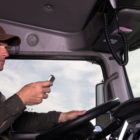Truckers Dealing with In-Cab Cameras
Video monitoring is changing the way truckers do their jobs. In 2020 alone the use of video cameras to monitor more than 3.6 million heavy trucks and many smaller delivery vehicles increased some 80%. Hundreds of thousands of video systems have been installed in American trucks over the last ten years. This kind of in-cab surveillance technology is a growing trend, with trucking companies seeing decreasing accident rates and insurance costs as a benefit. Research shows that dash cam systems can reduce the main causes of large-truck accidents such as speeding and distracted driving.
Accelerometers, gyroscopes and GPS equipment monitor nearly every function of the truck. Machine learning algorithms analyze drivers’ behavior, which is used for training. Companies see video systems as a natural complement to other active safety technologies such as stability control systems or reactive cruise-control. But the technology is a hard sell with drivers. Despite the compelling safety and financial benefits of dash cams, they can still be a source of stress and frustration for commercial fleet drivers. This sentiment is found frequently online and especially on social media. One anonymous American trucker named Josh says, “If the truck I’m in ever gets a camera installed in it facing me, facing inside this truck, this home where I live in, I will stop the truck and quit on the spot.”
Some big-rig drivers resent being electronically tethered to a machine that not only records traffic around the truck from different angles, but also their every move inside the cab. The Teamsters union and drivers say driver-facing cameras micromanage the driver, invades their privacy, and adds stress to the job. Newer systems allow drivers to log out during non-driving private time and only record video when triggered by an unusual event, such as a crash or sudden lane change.
A Canadian OTR trucker named Alecia says: “I don’t understand why you guys need to be in here watching my privacy. This is my time. Me time. Yes, I get that I am still on duty. I drive in my bra, sometimes. I’d like some privacy. I really would.”
Amazon has been rolling out a new AI-based (Artificial Intelligence) four-lens cameras in its branded delivery vans. Drivers are concerned about privacy and wonder who has control of their data. One driver named Vic doesn’t like the “Mentor” software which constantly monitors his driving, location, and mobile phone use. “If we went over a bump, the phone would rattle, the Mentor app would log that I used the phone … and boom, I’d get docked,” he said. Amazon drivers have to sign a release allowing the company to collect and save their biometric information.
Sharp Transport has also faced driver backlash against driver-facing cameras. Keith Wilson, Sharp’s director of safety and recruitment, says that drivers were calmed when they were told that the cameras did not record the sleeper area or what happened after the key was removed from the ignition. Three drivers out of 150 at Sharp resigned. Wilson says that the in-cab cameras paid off in 8 months.
In California, the Attorney General decided in 2014 that trucking companies can use driver-facing camera video to monitor and train their drivers, and Federal courts across the United States have ruled in recent years that most employees have few rights to privacy while on the job.
At Simco Logistics, according to VP Alan Drazen, “Harsh events” such as sudden braking have been reduced significantly, as have the company’s insurance premiums. Drivers use personal electronics in the cab about 90% less often now.
Drivers are being listened to, though, especially during the current driver shortage that is plaguing the industry. Some companies are opting to use only forward-facing cameras, eliminating driver-facing cameras. Others such as Illinois-based GP Transco pay drivers a two-cent-per-mile pay incentive to drive with in-cab video watching them.





